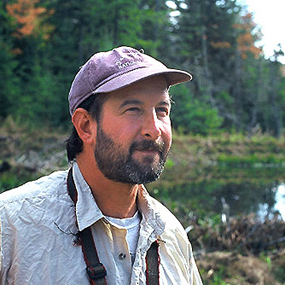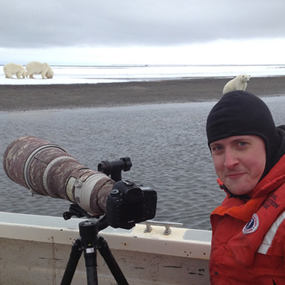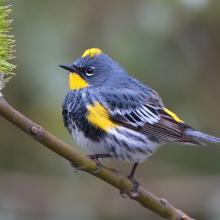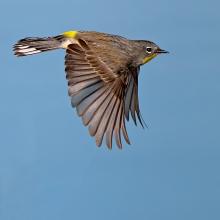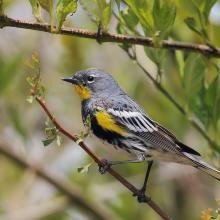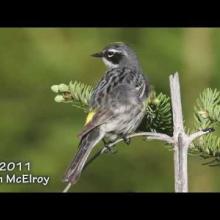

Join BirdNote tomorrow, November 30th!
Illustrator David Sibley and actor H. Jon Benjamin will face off in the bird illustration battle of the century during BirdNote's Year-end Celebration and Auction!
By winter, most warblers have migrated south. But the Yellow-rumped Warbler, which birders affectionately call “butterbutt” is a lesson in adaptation, notes Bryan Pfeiffer, a writer, naturalist, and educator who lives in Vermont. “In winter, when most of their kin are enjoying insects in the tropics, Yellow-rumps are finding food across parts of the West, the southern U.S. and north into New England,” he says. “With insects in short supply, the Yellow-rump turns to fruit . . .”
BirdNote®
Yellow-Rumped Warbler - The Winter Warbler
Adapted from a Vermont birding blog by Bryan Pfeiffer
This is BirdNote!
[Call of Yellow-rumped Warbler against the winter cold]
Vermont field naturalist and writer, Bryan Pfeiffer, writes today’s story:
It’s an aster in winter, sun through the clouds — a force of nature called the Yellow-rumped Warbler. Discover this songbird's buttery warmth, even when life outside seems to groan or crunch or crack in the cold. [Winter wind]
By now most warblers have migrated south. But the Yellow-rumped Warbler, which birders affectionately call “butterbutt” is a lesson in adaptation.
[Call of Yellow-rumped Warbler]
In winter, when most of their kin are enjoying insects in the tropics, Yellow-rumps are finding food across parts of the West, the southern U.S. and north into New England. With insects in short supply, the Yellow-rump turns to fruit: juniper, viburnums, and mountain ash.
But this warbler’s greatest dietary feat is that it also eats the fruits of bayberry and wax myrtle — the raw materials of folksy candles. Digesting wax takes guts — literally. To do so, it appears that Yellow-rumps possess elevated levels of bile salts, which aid digestion of saturated fats. [Continue calls of Yellow-rumped Warbler]
The Yellow-rump’s gastrointestinal talents probably account for its ability to inhabit a winter range farther north than its relatives. Particularly along the Atlantic coast, [where wax myrtle and bayberry can be abundant] birders, in a day, might find butterbutts in the hundreds — abundance unlike any wintering warbler in North America.
[Calls of Yellow-rumped Warbler and return of the wind]
You can share this show with a friend when you come to birdnote.org.
###
Bird sounds provided by The Macaulay Library of Natural Sounds at the Cornell Lab of Ornithology, Ithaca, New York. Calls of Yellow-rumped Warbler [135402] recorded by M. Andersen; calls of Yellow-rumped Warbler [ 107591] recorded by D.S. Herr.
Wind Nature Essentials #02 recorded by Gordon Hempton, of QuietPlanet.com
BirdNote’s theme music was composed and played by Nancy Rumbel and John Kessler.
Producer: John Kessler
Executive Producer: Chris Peterson
© 2016 Tune In to Nature.org January 2014/2018/2019/2023 Narrator: Michael Stein
ID# YRWA-03-2014-01-06YRWA-03
Adapted with permission from Bryan Pfeiffer's “The Winter Warbler.” Visit Bryan's blog at http://bryanpfeiffer.com/blog/.


